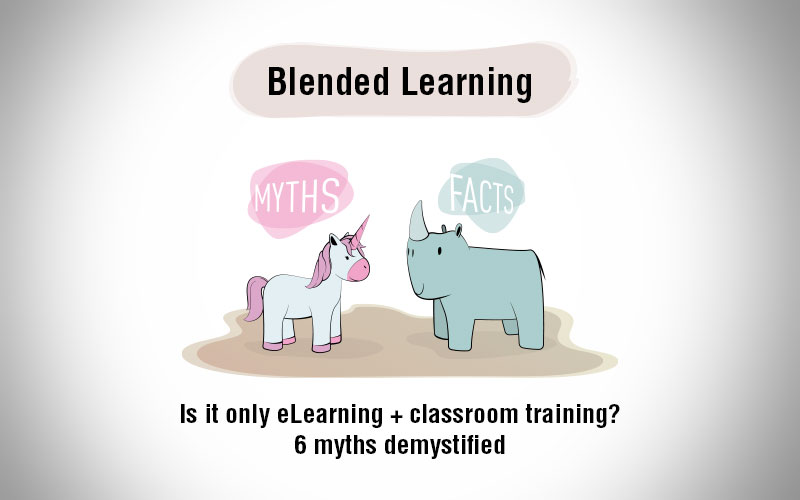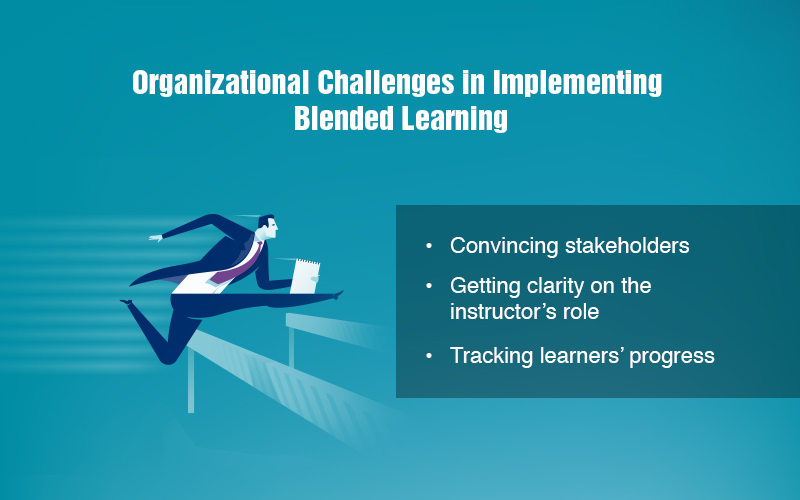Busting 6 Big Myths about Blended Learning

Which of these old and tested sayings is true? ‘Old is gold’ or ‘New is always better’? Training managers usually face such contrasting opinions while choosing between training formats. Should you continue with the tried and tested classroom training (Is old really gold?)? Or should you embrace new age learning trends with eLearning (Is new always better?)? If you are unable to choose, why not go for both by opting for blended learning?

Blended learning provides an opportunity to blend both online and offline training methods to arrive at an effective learning format that’s customized for your target learners. According to a survey by eLearning Industry, more than half of L&D respondents agreed blended learning increases training convenience, flexibility, learners’ participation, and cost savings. But there were a lot of dissenting opinions from some who did not even agree with the industry approved definition of blended learning.
The reasons for this contrast are the many misconceptions and myths around this training format which hinder L&D from leveraging its full potential. Let’s go ahead and debunk 6 such myths.
6 Common Myths about Blended Learning
- ILT + eLearning = blended learning
- It costs more than classroom training
- It’s just a steppingstone from ILT to eLearning
- Role of instructors and facilitators becomes superfluous
- ILT is the only facet of offline learning
- Your employees need to be tech savvy for blended learning to work
Debunking 6 Common Myths around Blended Learning
Myth #1: ILT + eLearning = Blended Learning
Blending learning doesn’t mean having a few classroom sessions followed by a few eLearning courses or vice-versa. You can have microlearning modules, social learning, and job-aids in the mix. There are many ways of delivering both online and offline training, depending on the learning requirement.
- You can start with introductory ILT sessions and follow them with eLearning modules to provide in- depth information.
- You can start with an eLearning pre-assessment and continue with classroom sessions.
- You can include job shadowing, mentoring, peer coaching, as well as workshops, seminars, and webinars in your blended training programs.
- You can deliver the entire training in the classroom and provide job-aids through mobile apps for performance support.
You can mix and match any format of online and offline learning and come up with a new cocktail of blended learning. But for an effecting training solution, you need to align the methods of delivering learning with the learning objectives.
→ Download Checklist: Is Blended Learning Right For Your Corporate Training?
Myth #2: It Costs More than Classroom Training
It’s generally assumed that technology is expensive. And an instructor standing in front of a whiteboard seems a less expensive option than designing an online learning course using rapid authoring tools. But if you factor in the cost of the venue, traveling and lodging, food, and loss of production time when employees are in training, and the necessity of doing this over and over again every few months, you might want to reconsider your options. Adopting a blended learning format does away with many of these expenses and provides an effective method of training.
The cost of eLearning within a blended learning program depends entirely on your training requirements, duration, and the level of interactivity in the courses. You can go in for simple, inexpensive formats such as videos and podcasts or more complex ones such as simulations and game-based designs.
You can also opt for rapid eLearning which reduces the production costs by almost 40%. The best thing about blended learning is that it’s an inexpensive way of training your global workforce who can all access the same training from wherever they are, whenever they need.
Myth #3: It’s Just a Steppingstone from ILT to eLearning
Transitioning your entire training program from ILT to eLearning can be a challenge, and blended learning can help make the process easier as employees can get acclimatized to online training. But to say blended learning is only a steppingstone in this process is a bit unfair, and also untrue. Blended learning is a way of getting the best of both offline and online learning. But most importantly, it is designed to meet specific demands of workplace training.
Let’s consider a training program for sales representatives on how to sell a newly launched product. As you know, there are two aspects to any sales process: knowing how to sell and having knowledge of the product they need to sell. eLearning modules on the details and specifications of the product will only fulfil part of the training requirement. But if you include a classroom role-playing session where learners collaborate and learn the art of selling, the training will effectively address both requirements.
The fundamental principle behind a blended learning solution is to recognize the best learning format that will provide complete and effective training.
Myth #4: There is NO Role for Instructors and Facilitators in Blended Learning
Nothing can be farther from the truth than the assumption that instructors are not important in a blended learning program. Or that they are less involved in online training than in classroom training just because there is no face-to-face interaction.
The fact is instructors do play an equally important role in online training because they are the reservoirs of knowledge who determine what information employees need, to do their jobs. All the course content that learners engage with is their brainchild. Consequently, they serve as subject matter experts who work alongside instructional designers to build an effective online training program.
Myth #5: ILT is the ONLY Form of Offline Learning
Here’s something we are all guilty of. We constantly use ILT, classroom training, and offline learning interchangeably when in fact they are not the same. ILT is a very specific form of classroom training in which an instructor leads the session. Classroom training can include workshops, virtual instructor-led training (VILT), and seminars. Similarly, offline training can include mentoring, peer-to-peer interactions, and collaborative learning sessions.
Myth #6: Learners Need to be Tech Savvy for Blended Learning to Work
This myth is particularly damaging for blended learning. Honestly, online learning is not rocket science and myths like these make navigating through an eLearning course seem harder than it actually is. Moreover, instructional designers put in a lot of thought and effort to make courses user-friendly and easily navigable.
While millennials do not need handholding when it comes to using technology, the same might not be true for all older employees who were not born into a digital world. Blended learning plays an important role in making learners comfortable with technology, opening up new avenues and modes of accessing knowledge. And as we go down this age of technological innovations, a completely digitalized workplace is not too far off.
Summing it Up
Hopefully, this attempt to dispel the myths and misconceptions about blended learning has made things clear. Now that you are convinced of its efficacy, the next challenge lies in figuring out whether blended learning is apt for your corporate training needs. Well, we have got you sorted. Download this free checklist and get answers to your questions.
Editor’s note: This post was originally published in 2020 and has been updated for comprehensiveness.





